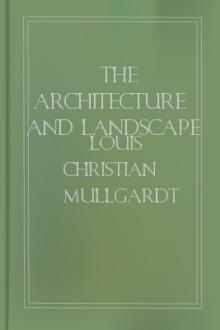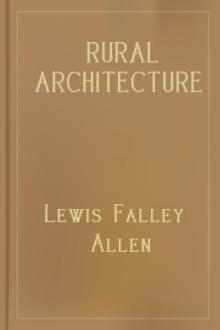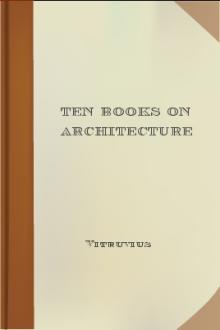The Architecture and Landscape Gardening of the Exposition, Louis Christian Mullgardt [the kiss of deception read online txt] 📗

- Author: Louis Christian Mullgardt
- Performer: -
Book online «The Architecture and Landscape Gardening of the Exposition, Louis Christian Mullgardt [the kiss of deception read online txt] 📗». Author Louis Christian Mullgardt
The Project Gutenberg EBook of The Architecture and Landscape Gardening of the Exposition, by Louis Christian Mullgardt
Copyright laws are changing all over the world. Be sure to check the copyright laws for your country before downloading or redistributing this or any other Project Gutenberg eBook.
This header should be the first thing seen when viewing this Project Gutenberg file. Please do not remove it. Do not change or edit the header without written permission.
Please read the “legal small print,” and other information about the eBook and Project Gutenberg at the bottom of this file. Included is important information about your specific rights and restrictions in how the file may be used. You can also find out about how to make a donation to Project Gutenberg, and how to get involved.
**Welcome To The World of Free Plain Vanilla Electronic Texts**
**eBooks Readable By Both Humans and By Computers, Since 1971**
*****These eBooks Were Prepared By Thousands of Volunteers!*****
Title: The Architecture and Landscape Gardening of the Exposition A Pictorial Survey of the Most Beautiful Achitectural Compositions of the Panama-Pacific International Exposition
Author: Louis Christian Mullgardt
Release Date: January, 2006 [EBook #9647] [Yes, we are more than one year ahead of schedule] [This file was first posted on October 13, 2003]
Edition: 10
Language: English
Character set encoding: ASCII
*** START OF THE PROJECT GUTENBERG EBOOK GARDENING OF THE EXPOSITION ***
Produced by David A. Schwan
The Architecture and Landscape Gardening of the Exposition
A Pictorial Survey of the Most Beautiful of the Architectural Compositions of the Panama-Pacific International Exposition
With an Introduction by
Louis Christian Mullgardt F.A.I.A. Architect of the Court of Ages Member of the Architectural Commission of the Exposition
1915
San Francisco
The courtesy of the Cardinell-Vincent Company, official photographers of the Panama-Pacific International Exposition, of granting permission to reproduce the selection of official photographs appearing in this volume, is gratefully acknowledged
To the spirit of Community Loyalty by which greatest results are accomplished. To generous Collective Energy which unites the world’s people in universal kindliness. To the wholesome people of our San Francisco, whose united efforts unconsciously disproved the impossible, this book is affectionately dedicated.
L. C. M.
Reflection
International Expositions are independent kingdoms in their corporate relation with other countries of the world. They are phantom kingdoms wherein the people do everything but sleep. They germinate and grow with phenomenal energy. Their existence is established without conquest and their magic growth is similar to the mushroom and the moonflower; they vanish like setting suns in their own radiance. Thousands of neophytes of every race, creed and color come with willing hearts and hands to do homage and bear manna to nourish the sinews of a phantom kingdom.
The National Constitution of phantom kingdoms commands that the Spirit of beauty, refinement, education, culture and frolic shall govern. The result is that they contain many palaces and shrines decorated with sculpture and painting and that the earth is studded with fountains and pools within tropical gardens. Such a Kingdom exists within a wonderful valley bordering on a great sea. It is surrounded by high velvet hills of fine contour and by many real cities. As the people look down on this phantom kingdom from the hill-tops, or from ships sailing on the water, they see Architecture nestling like flamingoes with fine feathers unfurled within a green setting.
If building Phantom Kingdoms symbolizes man’s highest aims on earth, then the same is true when building Real Kingdoms. Architecture and the sister arts are the most reliable barometers in recording human thought. They are direct exponents of a universal language wherein national progress is most clearly read.
People who build Phantom Kingdoms look hopefully for universal approval by all mankind.
L.C.M.
Contents
Reflection. Louis Christian Mullgardt The Architecture and Landscape Gardening of the Exposition. Louis Christian Mullgardt
Illustrations
The Rotunda of the Palace of Fine Arts—A View by Night. Hilda Van Sicklen, photo. (Frontispiece) Panorama—Exposition from Presidio Heights. W. Zenis Newton, photo Tower of Jewels—The Illumination by Night. J. L. Padilla, photo Fountain of Energy—A View in the South Gardens. W. Zenis Newton, photo Festival Hall—South Gardens and Mermaid Pool. W. Zenis Newton, photo Festival Hall—The Terrace and Colonnade. W. Zenis Newton, photo Festival Hall—Mermaid Pool in the Mist. Jesse T. Banfield, photo Palace of Horticulture—The Dome and East Entrance. W. Zenis Newton, photo Palace of Horticulture—Dome and Spires by Night. James M. Doolittle, photo Palace of Horticulture—The Colonnade on the East. W. Zenis Newton, photo Horticultural Gardens—Floral Exhibit in the Open Avenue of Palms—View from Administration Avenue. W. Zenis Newton, photo Palace of Education—Main South Portal. W. Zenis Newton, photo Palace of Education—One of the Minor Entrances. Pillsbury Pictures Court of Palms—The Sunken Pool by Night. W. Zenis Newton, photo Court of Palms—Portal, Palace of Education. Jesse T. Banfield, photo Court of Palms—Portal, Palace of Liberal Arts. W. Zenis Newton, photo Court of Palms—Italian Tower from Main Portal. W. Zenis Newton, photo Court of Palms—In the Colonnade by Night. William Hood, photo Court of Palms—A Curve in the Colonnade. W. Zenis Newton, photo Palace of Liberal Arts—Portal, From the South Gardens. Cardinell-Vincent, photo Palace of Liberal Arts—The Tower of Jewels by Night. J. L. Padilla, photo Palace of Liberal Arts—Elephant Fountain Niche by Night. W. Zenis Newton, photo The Tower of Jewels—The Great Roman Archway. W. Zenis Newton, photo The Tower of Jewels—Colonnade, The Fountain of Youth. W. Zenis Newton, photo The Palace of Manufactures—Portal, From the South Gardens. W. Zenis Newton, photo Court of Flowers—Fountain, Beauty and the Beast. J. L. Padilla, photo Court of Flowers—Portal of Varied Industries. W. Zenis Newton, photo Court of Flowers—A Vista in the Colonnade. William Hood, photo Court of Flowers—Italian Tower from Colonnade. W. Zenis Newton, photo Court of Flowers—The Friendly Lion at the Portal. Jesse T. Banfield, photo Palace of Varied Industries—Main Portal. Cardinell-Vincent, photo Avenue of Palms—The South Facade by Night. Cardinell-Vincent, photo Avenue of Progress—The Fine Vista to the Marina. W. Zenis Newton, photo Machinery Hall—The Central Arch in the Portal. W. Zenis Newton, photo Machinery Hall—The Colonnade in the Portal. W. Zenis Newton, photo Machinery Hall—One of the Minor Entrances. W. Zenis Newton, photo Palace of Mines—A Lamp Niche in the Court. W. Zenis Newton, photo Court of Ages—The Tower by Night Illumination. William Hood, photo Court of Ages—The Fountain of Earth. Pillsbury Pictures Court of Ages—The Garden of Hyacinths. W. Zenis Newton, photo Court of Ages—A Glimpse from the Colonnade. W. Zenis Newton, photo Court of Ages—A Vista in the Colonnade. W. Zenis Newton, photo Court of Ages—The Tower through North Aisle. W. Zenis Newton, photo Florentine Court—Palace of Transportation. W. Zenis Newton, photo Court of the Universe—Through Three Great Arches. W. Zenis Newton, photo Court of the Universe—Triumphal Arch, The Setting Sun. W. Zenis Newton, photo Court of the Universe—Triumphal Arch, The Rising Sun. Court of the Universe—Fountain of the Rising Sun. Pillsbury Pictures Court of the Universe—Fountain of the Setting Sun. W. Zenis Newton, photo Court of the Universe—The Fountain Pool and Tower. James M. Doolittle, photo Court of the Universe—Corinthian Colonnade and Gardens Court of the Universe—In the Promenade by Night. Jesse T. Banfield, photo Court of the Universe—A Niche and Urn by Night. Jesse. T. Banfield, photo Palace of Transportation—In the Corinthian Colonnade. W. Zenis Newton, photo Venetian Court—Palace of Agriculture. James M. Doolittle, photo Court of the Four Seasons—The Night Illumination. William Hood, photo Court of the Four Seasons—The Great Half Dome. Jesse T. Banfield, photo Court of the Four Seasons—The Western Archway. W. Zenis Newton, photo Court of the Four Seasons—One of the Colonnade Murals. W. Zenis Newton, photo Court of the Four Seasons—The Ionic Columns. Jesse T. Banfield, photo Court of the Four Seasons—The Colonnade and Lawn. W. Zenis Newton, photo Court of the Four Seasons—The North Colonnade by Night. W. Zenis Newton, photo Palace of Food Products—The Portal from the Gardens. W. Zenis Newton, photo Palace of Food Products—A Detail of the Main Portal. W. Zenis Newton, photo The Esplanade—North Facade, Column of Progress. W. Zenis Newton, photo North Facade—A View from the Bay. Pillsbury Pictures Palace of Food Products—A View from the Fine Arts Laguna. Jesse T. Banfield, photo Palace of Education—A View from the Fine Arts Laguna. Cardinell-Vincent, photo Palace of Education—The Half Dome of Philosophy. W. Zenis Newton, photo Palace of Education—The Fountain in the Portal. W. Zenis Newton, photo Administration Avenue—The Fine Arts Laguna Palace of Fine Arts—The Rotunda and Laguna. Jesse T. Banfield, photo Palace of Fine Arts—The Rotunda and Peristyle. W. Zenis Newton, photo Palace of Fine Arts—The Peristyle and Laguna Palace of Fine Arts—In the Peristyle Walk. W. Zenis Newton, photo Palace of Fine Arts—The Rotunda from the Peristyle. W. Zenis Newton, photo Palace of Fine Arts—The Peristyle Walk by Night. Jesse T. Banfield, photo Palace of Fine Arts—A Fountain in the Laguna. W. Zenis Newton, photo Palace of Fine Arts—A Picturesque Garden Fountain. Jesse T. Banfield, photo Palace of Fine Arts—The Garden and Fountain of Time. Jesse T. Banfield, photo California Building—Bell Tower and Forbidden Garden. California Building—The Arches of the Colonnade. W. Zenis Newton, photo California Building—A Vista in the Colonnade. W. Zenis Newton, photo California Building—The Forbidden Garden. Hilda Van Sicklen, photo California Building—The Semi-Tropical Garden. W. Zenis Newton, photo Netherlands Pavilion—As Seen from the Laguna. Pillsbury Pictures Italian Pavilion—The Piazzetta Venetia. Cardinell-Vincent, photo Italian Pavilion—In the Court Verrochio. James M. Doolittle, photo Avenue of the Nations—Tower of Sweden’s Pavilion. W. Zenis Newton, photo The Esplanade—A View of the Foreign Pavilions. W. Zenis Newton, photo The Esplanade—A View of the State Buildings. W. Zenis Newton, photo The Zone—A Holiday Gathering The Zone The Bizarre Decorations. J. L. Padilla, photo The Fireworks—Star Shells and Steam Battery. Jesse T. Banfield, photo Zone Salvo—The Final “Big Noise.” Jesse T. Banfield, photo
The Architecture and Landscape Gardening of the Exposition
The Architecture & Landscape Gardening
When San Francisco was destroyed by fire in 1906, many people predicted that the city would never be rebuilt. A great number of men and women packed their goods and chattels and hastily bade farewell to the still smoking ruins of a City That Was, firmly believing that destiny had determined that it should remain forever buried in its own ashes.
There was another class of men and women who were optimists. They predicted that the city would be rebuilt, but that it would require from twenty to thirty years.
There was still another class of men and women who knew by observation that it required no more time to build ten buildings than one, provided the Spirit of Energy and Determination existed, to fortify the desire.
We all know now that the Spirit of Energy and Determination did abound in San Francisco—that the City did not remain buried in its own ashes, and that it did not require from twenty to thirty years to rebuild it. The City was not only rebuilt in less than ten years, but, in addition thereto, an International Exposition, surpassing all previous Expositions, was built by its people.
San Francisco wisely selected for the location of this International Exposition what seemed to many to be an impossible site, for it was disorderly and uninteresting to look at. But the site was appropriately situated on the shores of San Francisco Bay—beautiful in its surroundings and most convenient alike to its citizens and visitors. It consisted of a pond and a strip of waste land and marsh land, apparently





Comments (0)